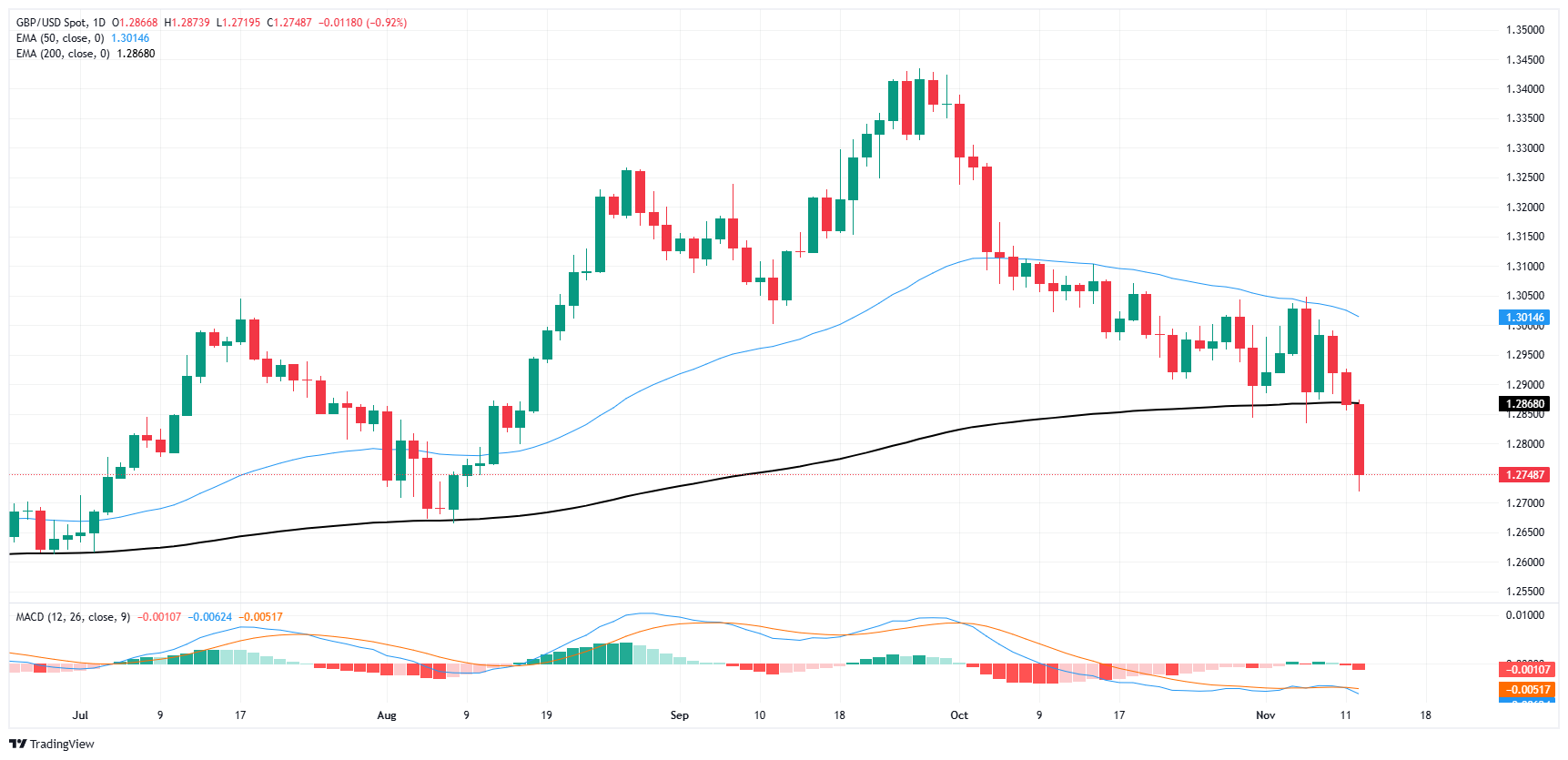- GBP/USD shed nearly a full percent on Tuesday.
- Markets are pulling back into the Greenback meaningfully.
- UK Unemployment Rate rose appreciably in September.
GBP/USD lost its footing on Tuesday, shedding almost a full percent after UK labor figures came in mixed, but all Cable traders could focus on was a steeper-than-expected upswing in the UK Unemployment Rate. Outside of the UK, a broad-market bullish recovery in Greenback flows is keeping the USD well-bid, exacerbating intraday losses for Cable.
UK labor figures mostly exceeded expectations, but wages growth keeps inflation concerns elevated. While unemployment claims were below forecasts, jobless benefits seeker counts still rose compared to the previous month’s revised figure.
The Bank of England’s (BoE) latest Monetary Policy Report is due early Wednesday, and investors will be looking out for hints of how the BoE plans to deal with a lopsided UK economy that continues to grapple with inflation figures. On the US side, key Consumer Price Index (CPI) inflation figures will land on markets. Full-fat CPI inflation is forecast to tick higher to 2.6% YoY compared to September’s print of 2.4%. Core CPI inflation is expected to hold steady at 3.3% YoY. The monthly figure for both inflation categories are broadly expected to hold flat month-on-month.
GBP/USD price forecast
The GBP/USD daily chart shows a significant bearish move, with the pair breaking below key support levels and intensifying selling pressure. The recent price action has pushed GBP/USD under the 200-day EMA (1.2868), which previously provided solid support and has now turned into resistance. This break below the 200-day EMA is a bearish signal that suggests a shift in the long-term trend to the downside, as bears take control of the market. Additionally, the 50-day EMA (1.3014) remains well above the current price, further confirming the bearish momentum.
The MACD indicator on the daily chart aligns with the bearish outlook, as the MACD line is below the signal line, and both lines are trending lower in negative territory. The histogram is expanding to the downside, indicating that bearish momentum is accelerating. This MACD setup implies that sellers are growing increasingly confident, and buyers have yet to show any significant strength to counter the downward trend. Unless there is a substantial recovery in the MACD, GBP/USD is likely to remain pressured in the near term.
Given the recent downside break and bearish technical signals, GBP/USD may continue to face downside risk toward the next psychological support level at 1.2700. If bearish momentum persists and this level is breached, the pair could target the 1.2600 area, where further support might emerge. However, a close back above the 200-day EMA would be required to alleviate some bearish pressure and potentially signal a consolidation phase. Until then, the path of least resistance remains to the downside, favoring sellers in the short term.
GBP/USD daily chart
Pound Sterling FAQs
The Pound Sterling (GBP) is the oldest currency in the world (886 AD) and the official currency of the United Kingdom. It is the fourth most traded unit for foreign exchange (FX) in the world, accounting for 12% of all transactions, averaging $630 billion a day, according to 2022 data. Its key trading pairs are GBP/USD, also known as ‘Cable’, which accounts for 11% of FX, GBP/JPY, or the ‘Dragon’ as it is known by traders (3%), and EUR/GBP (2%). The Pound Sterling is issued by the Bank of England (BoE).
The single most important factor influencing the value of the Pound Sterling is monetary policy decided by the Bank of England. The BoE bases its decisions on whether it has achieved its primary goal of “price stability” – a steady inflation rate of around 2%. Its primary tool for achieving this is the adjustment of interest rates. When inflation is too high, the BoE will try to rein it in by raising interest rates, making it more expensive for people and businesses to access credit. This is generally positive for GBP, as higher interest rates make the UK a more attractive place for global investors to park their money. When inflation falls too low it is a sign economic growth is slowing. In this scenario, the BoE will consider lowering interest rates to cheapen credit so businesses will borrow more to invest in growth-generating projects.
Data releases gauge the health of the economy and can impact the value of the Pound Sterling. Indicators such as GDP, Manufacturing and Services PMIs, and employment can all influence the direction of the GBP. A strong economy is good for Sterling. Not only does it attract more foreign investment but it may encourage the BoE to put up interest rates, which will directly strengthen GBP. Otherwise, if economic data is weak, the Pound Sterling is likely to fall.
Another significant data release for the Pound Sterling is the Trade Balance. This indicator measures the difference between what a country earns from its exports and what it spends on imports over a given period. If a country produces highly sought-after exports, its currency will benefit purely from the extra demand created from foreign buyers seeking to purchase these goods. Therefore, a positive net Trade Balance strengthens a currency and vice versa for a negative balance.
Information on these pages contains forward-looking statements that involve risks and uncertainties. Markets and instruments profiled on this page are for informational purposes only and should not in any way come across as a recommendation to buy or sell in these assets. You should do your own thorough research before making any investment decisions. FXStreet does not in any way guarantee that this information is free from mistakes, errors, or material misstatements. It also does not guarantee that this information is of a timely nature. Investing in Open Markets involves a great deal of risk, including the loss of all or a portion of your investment, as well as emotional distress. All risks, losses and costs associated with investing, including total loss of principal, are your responsibility. The views and opinions expressed in this article are those of the authors and do not necessarily reflect the official policy or position of FXStreet nor its advertisers. The author will not be held responsible for information that is found at the end of links posted on this page.
If not otherwise explicitly mentioned in the body of the article, at the time of writing, the author has no position in any stock mentioned in this article and no business relationship with any company mentioned. The author has not received compensation for writing this article, other than from FXStreet.
FXStreet and the author do not provide personalized recommendations. The author makes no representations as to the accuracy, completeness, or suitability of this information. FXStreet and the author will not be liable for any errors, omissions or any losses, injuries or damages arising from this information and its display or use. Errors and omissions excepted.
The author and FXStreet are not registered investment advisors and nothing in this article is intended to be investment advice.
Recommended content
Editors’ Picks

EUR/USD clings to daily gains near 1.0300 after US PMI data
EUR/USD trades in positive territory at around 1.0300 on Friday. The pair breathes a sigh of relief as the US Dollar rally stalls, even as markets stay cautious amid geopolitical risks and Trump's tariff plans. US ISM PMI improved to 49.3 in December, beating expectations.

GBP/USD holds around 1.2400 as the mood improves
GBP/USD preserves its recovery momentum and trades around 1.2400 in the American session on Friday. A broad pullback in the US Dollar allows the pair to find some respite after losing over 1% on Thursday. A better mood limits US Dollar gains.

Gold retreats below $2,650 in quiet end to the week
Gold shed some ground on Friday after rising more than 1% on Thursday. The benchmark 10-year US Treasury bond yield trimmed pre-opening losses and stands at around 4.57%, undermining demand for the bright metal. Market players await next week's first-tier data.

Stellar bulls aim for double-digit rally ahead
Stellar extends its gains, trading above $0.45 on Friday after rallying more than 32% this week. On-chain data indicates further rally as XLM’s Open Interest and Total Value Locked rise. Additionally, the technical outlook suggests a rally continuation projection of further 40% gains.

Week ahead – US NFP to test the markets, Eurozone CPI data also in focus
King Dollar flexes its muscles ahead of Friday’s NFP. Eurozone flash CPI numbers awaited as euro bleeds. Canada’s jobs data to impact bets of a January BoC cut. Australia’s CPI and Japan’s wages also on tap.

Best Forex Brokers with Low Spreads
VERIFIED Low spreads are crucial for reducing trading costs. Explore top Forex brokers offering competitive spreads and high leverage. Compare options for EUR/USD, GBP/USD, USD/JPY, and Gold.